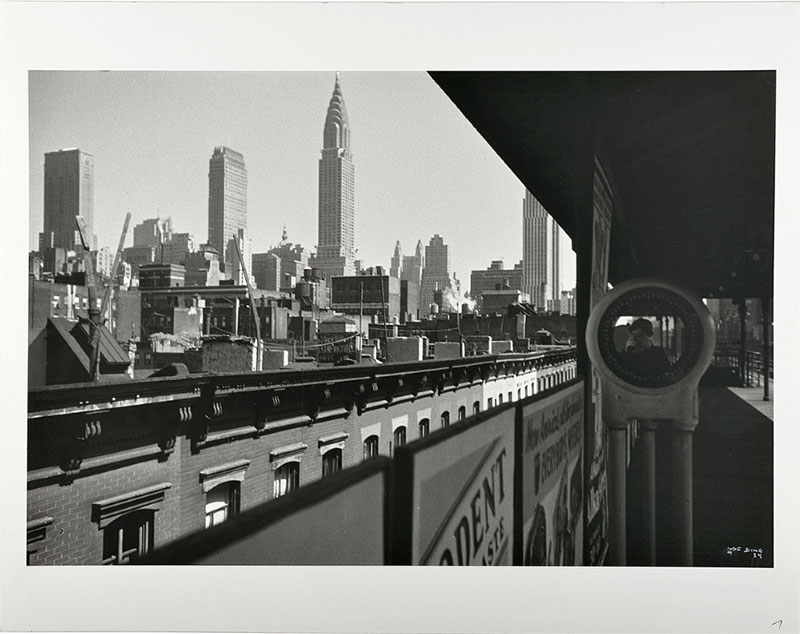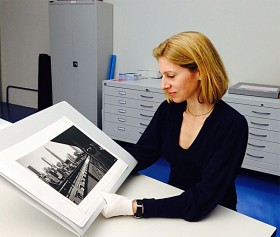A self-portrait shot by Ilse Bing on her first trip to New York in 1936 has been imprinted on my mind’s eye for a very long time. The image was up for sale only twice in the last twenty years. On the first occasion, in 2009, a vintage print went at auction for the princely sum of 25,000.00 EUR. Given its rarity and great market value, I imagined at the time that the enchanting image was unlikely ever to become a part of our collection. For me, it came to be the very epitome of wishful thinking.

Ilse Bing, “New York—The Elevated and Me,” print from 1988 of the original negative from 1936. Jewish Museum Berlin © Estate of Ilse Bing
The photograph depicts a station on the Elevated (subway line) in New York and the reflection in a small round mirror of the photographer with her Leica. The title “New York—The Elevated and Me” underscores the hybridity here of cityscape and self-portrait.
The strong diagonals on the left run together in the reflected image of the photographer and her camera: two extremely vectored lines that accentuate the dynamism of the Manhattan skyline. The photographer herself is shown in an environment otherwise completely empty of people and the image inquires thus into the relationship of human beings and the city. Ilse Bing observes the scene as an impartial outsider. She could not yet know when she took this photograph that she would migrate to the city five years later, take American citizenship, and remain there until her death.
Born in Frankfurt Main in 1899, Ilse Bing grew up in a middle-class Jewish family. In 1920 she began a degree course in mathematics and physics but soon switched to art history. She launched into photography because she needed images with which to illustrate her dissertation. She experimented with the medium and in 1929 began work as a photojournalist. That same year she purchased a Leica—at the time a revolutionary 35mm camera—which, years later, was to earn her the title of “Leica Queen.” In 1930 she was so thoroughly impressed by an exhibition of the Paris-based photographer Florence Henri that she decided to pack up and move to Paris.
In the summer of 1936 she traveled to New York at the invitation of the June Rhodes Gallery, the host of her first solo exhibition. Ilse Bing was fascinated by the city, which was so very different from Paris, and she was offered several commissions. Yet she turned them down, preferring instead to return to Paris. There, in 1937, she married the pianist Konrad Wolff, who was likewise a German Jew.
The invasion of German troops in France changed Ilse Bing’s life instantly. In 1940 she was forced to leave Paris then held at an internment camp in Gurs. In June 1941, after a long wait in Marseilles, she and her husband managed to flee to America. In New York she continued to work as a photographer but the success she had known in Paris eluded her. Times had changed. New York was increasingly becoming the international hotspot for photographic media and countless photographers were in search of work there. In the late 1950s Ilse Bing gave up photography and turned her attention instead to poetry, drawing and collages. In the late 1970s her photographic work was rediscovered, shown in numerous exhibitions and acquired by major museums. Bing enjoyed this late acclaim. She died in New York in 1998.
Ilse Bing shared the fate of many German-Jewish photographers whose life choices and exile led them from Paris to New York. Both cities accordingly play a significant role in the history of twentieth-century photography. The camera was a means for photographers in exile to discover their new environment and find their bearings in a foreign culture. In those early years, their “outsider’s gaze” proved not infrequently more exacting and critical than that of the more long-standing New Yorkers among their colleagues.
The photograph “New York—The Elevated and Me” is emblematic of Ilse Bing’s fate as an emigrée. In projecting the interaction of a self-portrait and an urban environment it raises the questions: Who am I? Who or what defines my identity?

“In our collection at last.” Theresia Ziehe surveys the photograph by Ilse Bing. © Jewish Museum Berlin, photo: Julia Kouzmenko
In late 2014 I managed to acquire the long-yearned-for photograph. For me, it was a magic moment. Hope and worry preceded it but much happiness came in its wake. Moreover, it was possible to acquire the photograph for our collection at a price far below original estimates of its market value . But like all good fortune, mine too had its shadow side: our new acquisition is a print from the year 1988. It is signed and dated in white ink in the lower right corner, but the maker of the print mistakenly noted the date of the negative as being 1934.
However, for the photo collection of a museum devoted to cultural history, whether the print is an original from 1936 or was made only in 1988 is not of primary significance. Crucial rather, is the motif and historical import of a photograph.
I longed for many years to be able to acquire “New York—The Elevated and Me” for our photographic collection. That I finally succeeded will hopefully bring much happiness to other people too, in the future.
Theresia Ziehe, Curator for Photography
Further information in German about the photography can be found in our online collection.

I too love this image, I am glad you finally aquired it. I have only just discovered her work.